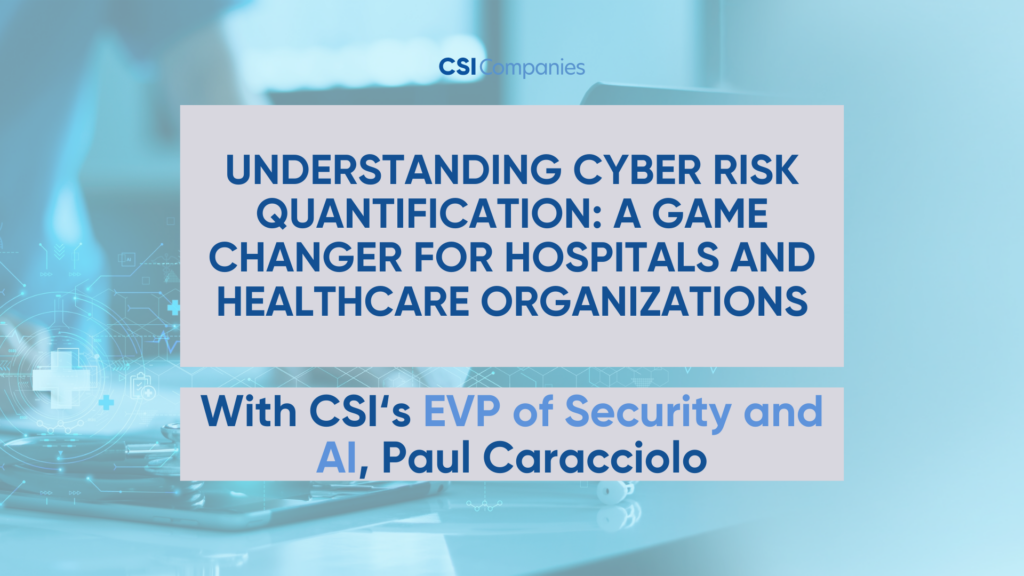
Cybersecurity is obviously a critical concern for hospitals and healthcare organizations. Cybersecurity and HIPAA compliance are typically managed with a biannual or yearly audit, which then generates items to be remediated to bring the organization into compliance. As cyber threats become more sophisticated, traditional methods of assessing and managing these risks are proving inadequate. This is evident in the number of recent breaches across healthcare. Enter Cyber Risk Quantification (CRQ) – a revolutionary approach that is transforming how organizations understand, manage, communicate, and mitigate cyber risks. Additionally, CRQ allows you visibility into HIPAA and Cybersecurity compliance in real-time and the ability to manage your compliance programs proactively in real-time.
What is Cyber Risk Quantification?
Cyber Risk Quantification is a methodology automated with a software platform that applies quantitative analysis to cyber risks, translating them into financial terms that can be easily understood and managed. This platform can also act as the repository of records for all risks across the organization, thus giving a comprehensive risk view instead of chasing spreadsheets from various departments. This new window into the organization’s risks now has tremendous value, not only for the CIO but also for the CEO, CFO, and the board of directors. Unlike traditional qualitative methods, which often rely on subjective assessments and vague categorizations (e.g., “high,” “medium,” and “low” risk), CRQ uses data-driven models to provide a clear picture of the potential financial impact of cyber threats on an organization. Cybersecurity is no longer a black hole, which would typically only give visibility through a 6 month or yearly audit report. The automated CRQ function gives constant real-time insight into risks and costs and allows real-time management of risk.
CRQ Involves Several Key Steps:
1. Identifying Assets and Threats: Pinpointing critical assets and potential threats that could impact them.
2. Assessing Vulnerabilities: Evaluating the vulnerabilities that could be exploited by these threats.
3. Estimating Likelihood and Impact: Estimate the likelihood of different threats materializing and their potential financial impact.
4. Understanding and evaluating existing controls: Determine what controls an organization has in place to mitigate risk and its operating effectiveness.
5. Calculating Risk Exposure: Combining these factors to calculate the overall financial risk exposure.
The Pain Points CRQ Solves for Organizations
1. Lack of Clarity in Risk Assessment: Traditional risk assessments often result in ambiguous findings that are difficult to interpret and act upon. CRQ provides a clear, quantifiable understanding of risks, enabling better decision-making.
2. Ineffective Risk Management: Without a precise understanding of risk, organizations struggle to prioritize their security investments effectively. CRQ helps identify which risks pose the greatest financial threat, guiding more strategic allocation of resources.
3. Communication Challenges: Communicating cyber risk to non-technical stakeholders can be challenging. CRQ translates technical risk into financial terms, making it easier for executives and board members to grasp the significance and make informed decisions.
4. Regulatory Compliance: Regulators are increasingly demanding more rigorous and transparent risk management practices. CRQ helps organizations meet these requirements by providing a robust framework for assessing and reporting on cyber risks.
The Benefits of Cyber Risk Quantification
1. Enhanced Decision-Making: By clearly illustrating the financial impact of cyber risks, CRQ empowers organizations to make more informed decisions about where to invest in cybersecurity measures.
2. Improved Risk Management: With a quantitative understanding of risk, organizations can prioritize their efforts more effectively, focusing on the most significant threats and vulnerabilities.
3. Cost Efficiency: CRQ enables organizations to optimize their cybersecurity budgets, ensuring that resources are directed towards the most critical areas and avoiding over- or under-investment in security measures.
4. Stronger Justification for Investments: Quantifying risk in financial terms helps build a compelling business case for cybersecurity investments, making it easier to secure funding and support from senior management.
5. Better Communication: CRQ facilitates clearer communication of cyber risks across the organization, helping to align technical and non-technical stakeholders on risk priorities and strategies.
6. Regulatory Compliance: A structured approach to quantifying and managing risk supports compliance with regulatory requirements and demonstrates a commitment to robust cybersecurity practices.
By translating complex cyber risks into financial terms, CRQ provides the clarity and precision needed to make informed, strategic decisions about cybersecurity investments. This not only enhances an organization’s ability to manage and mitigate risks but also strengthens its overall resilience in the face of evolving cyber threats. As the digital landscape continues to change, embracing CRQ will be crucial for organizations seeking to stay ahead of the curve and protect their critical assets.
About the Authors

Paul J. Caracciolo is the Executive Vice President of CSI Companies’ Cybersecurity, Risk, and AI Management practice. Our practice uses automated risk and Cybersecurity compliance tools to get hospitals in a posture of real-time management of their environments. Our offerings have a large impact relating to very clear ROI and cost savings in these applications. An added benefit is that we enable organizations to take a proactive approach to managing risk and security instead of being in a firefighting, reactive, and outdated periodic audit mode. Paul can be reached at: pcaracciolo@csicompanies.com.
Dixon Wright is the VP of GRC at TrustCloud, an AI platform for GRC transformation that delivers assurance for CISOs and risk management and helps their teams focus on the strategic rather than the mundane. TrustCloud’s platform helps CISOs deploy an integrated platform for cyber risk quantification, customer assurance, and third-party risk management. Dixon can be reached at: dixon@trustcloud.ai.